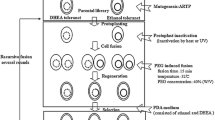Abstract
Hydroxylation of dehydroepiandrosterone (DHEA) to 3β,7α,15α-trihydroxy-5-androstene-17-one (7α,15α-diOH-DHEA) by Colletotrichum lini ST-1 is an essential step in the synthesis of many steroidal drugs, while low DHEA concentration and 7α,15α-diOH-DHEA production are tough problems to be solved urgently in industry. In this study, the significant improvement of 7α,15α-diOH-DHEA yield in 5-L stirred fermenter with 15 g/L DHEA was achieved. To maintain a sufficient quantity of glucose for the bioconversion, glucose of 15 g/L was fed at 18 h, the 7α,15α-diOH-DHEA yield and dry cell weight were increased by 17.7 and 30.9 %, respectively. Moreover, multi-step DHEA addition strategy was established to diminish DHEA toxicity to C. lini, and the 7α,15α-diOH-DHEA yield raised to 53.0 %. Further, a novel strategy integrating glucose-feeding with multi-step addition of DHEA was carried out and the product yield increased to 66.6 %, which was the highest reported 7α,15α-diOH-DHEA production in 5-L stirred fermenter. Meanwhile, the conversion course was shortened to 44 h. This strategy would provide a possible way in enhancing the 7α,15α-diOH-DHEA yield in pharmaceutical industry.





Similar content being viewed by others
References
Shashi BM, Subhadra G (1997) Advances in microbial steroid biotransformation. Steroids 62:332–345
Fernandes P, Cruz A (2003) Microbial conversion of steroid compounds: recent developments. Enzyme Microb Tech 32:688–705
Hogg JA (1992) The steroid community, and Upjohn in perspective: a profile of innovation. Steroids 257:593–616
Mohammad AF, Sina A (2008) Microalgal biotransformation of steroids. J Phycol 44:27–37
Woodley JM (2008) New opportunities for biocatalysis: making pharmaceutical processes greener. Trends Biotechnol 26:321–327
Robel P, Baulieu EE (1995) Dehydroepiandrosterone (DHEA) is a neuroactive neurosteroid. Ann NY Acad Sci 774:82–110
Qianxing M, Shifang L (2009) Genome-wide analysis of DHEA- and DHT-induced gene expression in mouse hypothalamus and hippocampus. J Steroid Biochem 114:135–143
Mahato B, Mazumder I (1989) Current trends in microbial steroid transformations. Phytochemistry 34:883–898
Romano A, Romano D (2006) Steroid hydroxylations with Botryodiplodia malorum and Colletotrichum lini. Steroids 71:429–434
Lobastova TG, Gulevskaya SA (2009) Dihydroxylation of dehydroepiandrosterone in positions 7α and 15α by mycelial fungi. Appl Biochem Micro 6:617–622
Hui L, Zhenzhen F (2014) The efficient production of 3β,7α,15α-trihydroxy-5-androsten-17-one from dehydroepiandrosterone by Gibberella intermedia. Appl Biochem Biotech 174:2960–2971
Rita B (2006) Cytochromes P450 as versatile biocatalysts. J Biotechnol 124:128–145
Teresa K, Natalia M (2011) Hydroxylation of DHEA, androstenediol and epiandrosterone by Mortierella isabellina AM212. Evidence indicating that both constitutive and inducible hydroxylases catalyze 7α- as well as 7β-hydroxylations of 5-ene substrates. Org Biomol Chem 9:5414–5422
Amit VP, Christa EF (2013) NADPH P450 oxidoreductase: structure, function, and pathology of diseases. Pharmacol Therapeut 138:229–254
Hui L, Zhenzhen F (2013) Improvement of the steroid dihydroxylation efficiency from dehydroepiandrosterone using a substrate pre-induction biotransformation process. Biotechnol Bioproc E 18:486–490
Hui L, Siqi Y (2015) Enhanced 3β,7α,15α-Trihydroxy-5-Androsten-17-One Production from Dehydroepiandrosterone by Colletotrichum lini ST-1 resting cells with tween-80. Appl Biochem Biotech. doi:10.1007/s1201001518603
Yan W, Hui L (2015) Improvement of NADPH-dependent P450-mediated biotransformation of 7α,15α-diOH-DHEA from DHEA by a dual cosubstrate-coupled system. Steroids 101:15–20
Rita B, Vlada BU (2014) Cytochromes P450 as promising catalysts for biotechnological application: chances and limitations. Appl Microbiol Biot 98:6185–6203
Heng L, Zhenzhen F (2014) Enhanced biotransformation of dehydroepiandrosterone to 3 beta,7 alpha,15 alpha-trihydroxy-5-androsten-17-one with Gibberella intermedia CA3-1 by natural oils addition. J Ind Microbiol Biot 41:1497–1504
Kim PY, Pollard DJ (2007) Substrate supply for effective biocatalysis. Biotechnol Prog 23:74–82
Yan W, Hui L (2014) Enhancement of steroid hydroxylation yield from dehydroepiandrosterone by cyclodextrin complexation technique. Steroids 84:70–77
Won HL, Myoung DK (2013) Engineering of NADPH regenerators in Escherichia coli for enhanced biotransformation. Appl Microbiol Biot 97:2761–2772
Acknowledgments
This work is financially supported by the National High-Tech R&D Program (No. 2011AA02A211) and the National Natural Science Foundation of China (No. 31300026).
Author information
Authors and Affiliations
Corresponding author
Ethics declarations
Conflict of interest
The authors declared that they have no conflicts of interest to this work.
Rights and permissions
About this article
Cite this article
Li, C., Li, H., Sun, J. et al. Production of 7α,15α-diOH-DHEA from dehydroepiandrosterone by Colletotrichum lini ST-1 through integrating glucose-feeding with multi-step substrate addition strategy. Bioprocess Biosyst Eng 39, 1259–1266 (2016). https://doi.org/10.1007/s00449-016-1604-y
Received:
Accepted:
Published:
Issue Date:
DOI: https://doi.org/10.1007/s00449-016-1604-y




